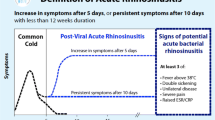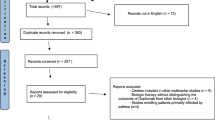Abstract
Purpose
The aim of the study is to compare the effects of continuous positive airway pressure (CPAP) on the nasal cavities of patients with obstructive sleep apnoea (OSA) and with or without allergic rhinitis (AR/nonAR).
Methods
This paper is a prospective, longitudinal study. Thirty-four consecutive CPAP treatment-adherent patients with OSA (17 AR and 17 nonAR) were evaluated before and 2 months after treatment, by means of clinical (otorhinolaryngological symptoms, daytime sleepiness, overall and rhinoconjunctivitis-specific quality of life), anatomical (otorhinolaryngological examination), functional (auditory function, tubal function, nasal airflow, and mucociliary clearance), and biological variables (nasal cytology). No humidifier or anti-allergy medicines were used during treatment.
Results
Before treatment, patients with AR presented a higher score, compared to nonAR in rhinitis symptoms (4.82 ± 2.53 vs. 0.93 ± 1.02, p = 0.000), otologic symptoms (2.06 ± 1.95 vs. 0.44 ± 0.72, p = 0.004), cutaneous/ocular symptoms (2.12 ± 2.17 vs. 0.65 ± 1.17, p = 0.052), immunoglobulin E (181.82 ± 126.09 vs. 66.13 ± 97.97, p = 0.004), and nasal neutrophils (14.42 ± 31.94 vs. 0.16 ± 0.39, p = 0.031). After treatment, nonAR and AR groups improved in daytime sleepiness (11.53 ± 4.60 vs. 7.53 ± 2.87, p = 0.000 and 13.76 ± 4.93 vs. 7.53 ± 4.41, p = 0.001) respectively and increased nasal neutrophil (0.16 ± 0.39 vs. 5.78 ± 9.43, p = 0.001 and 14.42 ± 31.94 vs. 79.47 ± 202.08, p = 0.035). The symptoms and quality of life improved in patients with AR. NonAR patients, significantly increase nasal dryness (1.65 ± 1.27 vs. 0.00, p = 0.002) and mucociliary clearance times (38.59 ± 24.90 vs. 26.82 ± 23.18, p = 0.016).
Conclusions
CPAP produces inflammation with increased nasal neutrophil levels in AR and nonAR patients. Nevertheless, patients with AR observed an improvement in nasal symptoms and quality of life, whereas in patients without AR, a relevant worsening of nasal dryness and mucociliary transport was observed.
Similar content being viewed by others
References
Basner R (2007) Continuous positive airway pressure for obstructive sleep apnea. N Engl J Med 356(17):1751–1758
Catcheside PG (2010). Preditors of continuous positive airway pressure adherence. F1000 medicine reports 2: 70.
Devouassoux G, Lévy P, Rossini E et al (2007) Sleep apnea is associated with bronchial inflammation and continuous positive airway pressure-induced airway hyperresponsiveness. J Allergy Clin Immunol 119(3):597–603
Weaver TE, Grunstein RR (2008) Adherence to continuous positive airway pressure therapy: the challenge to effective treatment. Proc Am Thorac Soc 5(2):173–178
Bauchau V, Durham SR (2004) Prevalence and rate of diagnosis of allergic rhinitis in Europe. Eur Respir J 24:758–764
Grupo Español de Sueño (2005). Consenso Nacional sobre el síndrome de apneas-hipopneas del sueño. Arch Bronconeumol 41: 3–110.
Vilaseca I, Lehrer-Coriat E, Torres M, Aguilar F, Almendros I, Martínez-Vidal BM, Montserrat JM (2016) Early effects of continuous positive airway pressure in a rodent model of allergic rhinitis. Sleep Med 27-28:25–27
Lloberes P, Durán-Cantolla J, Martínez-García MA, Marín JM, Ferrer A, Corral J et al (2011) Diagnosis and treatment of sleep apnea-hypopnea syndrome. Spanish Society of Pulmonology and Thoracic Surgery. Arch Bronconeumol 47(3):143–156
Aguilar F, Cisternas A, Montserrat JM, Ávila M, Torres-López M, Iranzo A, Berenguer J, Vilaseca I (2016) Efecto de la presión positiva continua nasal sobre las fosas nasales de pacientes con Síndrome de Apneas del Sueño sin patología nasal previa. Factores predictivos de cumplimiento. Arch Bronconeumol 52:519–526
Dreborg S, Backma A, Basomba A, Bousquet J, Dieges P, Malling HJ (1989) Skin tests used in type I allergy testing. Allergy 44:1–59
Johns MW (1993) Daytime sleepiness, snoring and obstructive sleep apnea. The Epworth Sleepniness Scale. Chest 103(1):30–36
Vilagut G, Ferrer M, Rajmil M, Rebollo P, Permanyer-Miralda G, Quintana JM et al (2005) El cuestionario de salud SF-36 español: una década de experiencia y nuevos desarrollos. Gac Sanit 19(2):135–150
Juniper EF, Thompson AK, Ferrie PJ, Roberts JN (1999) Validation of a standardised version of the rhinoconjunctivitis quality of life questionnaire. J allergy Clin Immunol 104(2pt1):364–369
Stewart MG, Witsell DI, Smith TL, Weaver EM, Yueti B, Hannley MT (2004) Development and validation of the Nasal Obstruction Symptom Evaluation (NOSE) Scale. Otolaryngology - Head and Neck Surg 130(2):157–163
Rasp G, Kramer MF, Ostertag P, Kastenbauer E (2000) A new system for the classification of ethmoid polyposis. Effect of combined local and systemic steroid therapy. Laryngorhinootologie 79(5):266–272
Rasp G (2002) Eosinophil inflammation of the nasal mucosa. Laryngorhinootologie 81(7):491–498
Fabra Llopis JM (1990) Rinomanometría anterior activa informatizada: criterios de normalidad y fiabilidad de la prueba. Doctoral Thesis. Universidad Autónoma de Barcelona, Barcelona
Andersen IB, Camner P, Jensen PL, Philipson K, Proctor DF (1974) A comparison of nasal and tracheobroncuial clearance. Arch Environ Health 29(5):290–293
Portmann M, Portmann C (1979). Audiometría Clínica. Barcelona: Toray-Masson (3rd edition).
Skoczinski S, Ograbek-Król M, Tazbirek M, Semik-Orzech A, Pierzehala W (2008) Short-term CPAP treatment induces a mild increase in inflammatory cells in patients with sleep apnea syndrome. Rhinology 46(2):144–150
Gelardi M, Carbonara G, Maffezzoni E, Marvisi M, Quaranta N, Ferri R (2012) Regular CPAP utilization reduces nasal inflammation assessed by nasal cytology in obstructive sleep apnea syndrome. Sleep Med 13(7):859–863
Pawankar R, Hayashi M, Yamanishi S, Igarashi T (2015) The paradigm of cytokine networks in allergic airway inflammation. Curr Opin Allergy Clin Immunol 15(1):41–48
Martinez B, Farré R, Montserrat JM, Torres M, Almendros I, Aguilar F et al (2010) Effects of heated humidification on nasal inflammation in a CPAP rat model. Sleep Med 11(4):413–416
Lacedonia D, Salerno FG, Carpagnano GE, Sabato R, Depalo A, Foschino-Barbaro MP (2011) Effects of CPAP-therapy on bronchial and nasal inflammation in patients affected of obstructive sleep apnea syndrome. Rhinology 49(2):232–237
Bossi R, Piatti G, Roma E, Ambrosetti U (2004) Effects of long-term nasal continuous positive airway pressure therapy on morphology, function, and mucociliary clearance of nasal epithelium in patients with obstructive sleep apnea syndrome. Laryngoscope 114(8):1431–1434
Saka C, Vuralkan E, Fırat IH, Alicura S, Hücümenoğlu S, Akın I et al (2012) The effects of CPAP treatment on nasal mucosa in patients with obstructive sleep apnea. Eur Arch Otorhinolaryngol 269(9):2065–2067
Acknowledgements
The authors would like to thank Maite Carrión, Ainhoa Asensio, and Carmen León for their help carrying out this project.
Author information
Authors and Affiliations
Corresponding author
Ethics declarations
Funding
This study was funded under Grant FISS PI07/0318. The sponsor had no role in the design or conduct of this research.
Conflict of interest
The authors declare that they have no conflict of interest.
Ethical approval
All procedures performed in studies involving participants were in accordance with the ethical standards of the institutional and/or national research committee and with the 1964 Helsinki declaration and its later amendments or comparable ethical standards.
Informed consent
Informed consent was obtained from all individual participants included in the study.
Rights and permissions
About this article
Cite this article
Cisternas, A., Aguilar, F., Montserrat, J.M. et al. Effects of CPAP in patients with obstructive apnoea: is the presence of allergic rhinitis relevant?. Sleep Breath 21, 893–900 (2017). https://doi.org/10.1007/s11325-017-1510-9
Received:
Revised:
Accepted:
Published:
Issue Date:
DOI: https://doi.org/10.1007/s11325-017-1510-9




